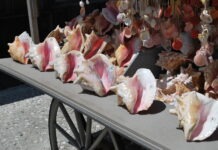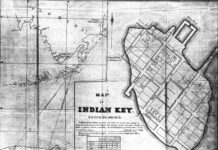(Editor’s Note: This week’s installment of The Bum Farto Files includes details of a murder and crime scene that some readers may find disturbing.)
Key West Fire Chief Joseph “Bum” Farto disappeared on Feb. 16, 1976, while awaiting sentencing for a drug trafficking conviction stemming from Operation Conch – a sting operation that found Farto allegedly selling cocaine from the city’s fire station. Bum became the Jimmy Hoffa of Key West, and the island has swirled with rumors of his fate since he disappeared. David Sloan and Quincy Perkins have launched an unparalleled investigation into Chief Farto’s life, legends and disappearance in an attempt to find the truth. Each week they will share elements of their research here in the Keys Weekly while working to solve one of the greatest mysteries in the history of Key West. Share your Bum Farto tips and stories at www.findbumfarto.com.
Blood spatter covered the walls of a Whitmarsh Lane bathroom on Aug. 17, 1975. Officer Charles Powers and Detective Robert Lastre were the first on the scene. A black male subject slumped in the bathtub. Blood trickled from his mouth and gray matter seeped from his head. Duct tape covered the washcloth in his mouth, and his hands were bound. The victim had two bullet wounds in his head and one in his chest.
Detective Lastre knew the dead man. It was Titus Rudolph Walters, the confidential informant who introduced Bum Farto to undercover agent Larry Dollar as part of the drug sting dubbed Operation Conch.
Born in 1941, Walters was only 34 years old when he was murdered. He’d had several run-ins with the law, yet sources who knew him describe Walters as “a bad boy” and “also harmless.”
In 1972, Walters had been charged with murdering Antonio Boan during an alleged heroin deal that went bad on Petronia Street. He was sentenced to 15 years in prison, but returned to the Keys after several months to stand trial on a drug charge.

Bum Farto’s friend and legal counselor, Manny James, represented Walters on the drug charge. Walters was found guilty and sentenced to one year in jail, but the courts soon reversed Walters’ murder conviction on appeal and he was released on parole. During this time, a Monroe County sheriff’s detective recruited Titus as a confidential informant.
On Aug. 1, 1975, Walters led Detective Charles Major and Agent Larry Dollar to a motel room where a drug dealer named Bobby Marion Francis was selling narcotics. They arrested Francis, who swore revenge on Walters as authorities took him in.
Francis made good on his promise 17 days later, when he and six friends lured Titus Walters to a home on Whitmarsh Lane.
Francis ordered Walters to his knees and held him at gunpoint while the rest of the group sequestered in the kitchen. Francis squeezed the trigger and a .38 caliber bullet entered Walters’ head. Walters didn’t die. Francis duct taped Walters’ wrists, dragged him into the bathroom, and forced him to a backward-seated position on the toilet. He shoved a washcloth in Walters’ mouth, covered it with tape to stifle the screams, took money from Walters’ pocket and sent two of the crew to procure needles and Drano. When they returned, Francis injected Walters with a mixture of drain cleaner, battery acid and heroin. Then he watched Walters and waited for him to die.
According to witness statements, Francis emerged from the bathroom after 15 to 20 minutes saying, “Damn, his momma must have some strong blood roots, that f****r just won’t die!” Francis looked at the person who owned the home and said, “I’m gonna owe you a pillow,” and threw Walters into the bathtub, forcing the pillow against his head. Francis fired a second shot, but Walters didn’t die. A final bullet shot through the heart caused massive hemorrhaging and death. Francis emerged from the bathroom, laughing. Walters died a death no man deserves. He was the first casualty of Operation Conch.
Police arrested four suspects for the murder. Twenty-three days later, “handcuff day” of Operation Conch unleashed a string of arrests that filled the local jail. Key West Public Defender John Keane requested permission to withdraw from representing defendants in the murder of Walters as well as 12 others arrested on drug charges in Operation Conch. Keane explained that while representing Walters on a grand larceny charge, he was told things in confidence that now created a conflict of interest.
“There are definitely conflicts of interest in representing those charged in the Walters case and the drug cases later,” Keane said. It was business as usual in Conch Town.
Bobby Marion Francis went to the electric chair. Titus Rudolph Walters went to the Key West Cemetery. There were no winners, only losers. And “handcuff day” was just beginning.



























